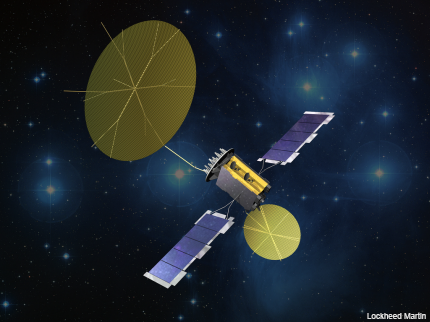Pair of mesh reflectors boost Navy’s satcom network
The reflectors on satellites in the MUOS constellation help increase communications capacity 16-fold.

The 14-meter mesh reflectors contribute to a 16-fold increase in capacity.
A pair of "mesh reflectors" used to boost capacity on the U.S. Navy's space-based mobile phone network have deployed successfully on the newest satellite in the constellation, antenna manufacturer Harris Corp. announced this week.
The unfurling antennas were launched Sept. 2 aboard the fourth payload in the Navy's constellation of Mobile User Objective System (MUOS) satellites. Built by Lockheed Martin, the MUOS constellation serves as a smartphone-like network in space designed to provide secure satellite voice and data communications for mobile forces.
Harris, based in Melbourne, Fla., estimates the eight reflectors now deployed in the MUOS constellation provide a 16-fold increase in communications capacity while also supporting a legacy UHF system.
The latest deployment of the seventh and eighth reflectors in the five-satellite MUOS constellation gives the Navy near-global coverage for simultaneous transmission and reception of secure voice and data over a high-speed, IP-based network. Global coverage is achieved because the MUOS constellation has a "beyond-line-of sight" capability.
The Navy and its contractors have been building out MUOS for several years. The first two satellites were launched 2012 and 2013. After some successful tests, the third satellite went up in January, with the fourth being launched in September, effectively giving the system global coverage. The launch of the fifth MUOS satellite, which will act as a spare, is planned for 2016.
Each MUOS satellite is equipped with two 14-meter mesh reflectors that are unfurled once the vehicle has reached its designated orbit. The reflectors employ a multiple-beam technology that boosts the number of users and amount of voice and data traffic the MUOS constellation can support. A legacy UHF antenna measures only 5.4 meters, Harris noted.
After they are unfurled, the gold mesh reflectors are secured to the satellite with precision booms also built by Harris. The antenna reflectors are based on Harris' fixed mesh reflector technology and composite support structures developed by San Diego-based Vanguard.
The company also supplies tactical radio terminals for the MUOS network. The radio supplier said MUOS capability for its current Falcon III manpack radios could be added via a software upgrade. It claims more than 30,000 Harris radios have been deployed with the ability to host MUOS waveform software.
Harris also is pitching its AN/PRC-158 multichannel radio as a host for the MUOS waveform. The new radio was initially designed to compete for the Army's Handheld, Manpack and Small Form Fit radio contract.



